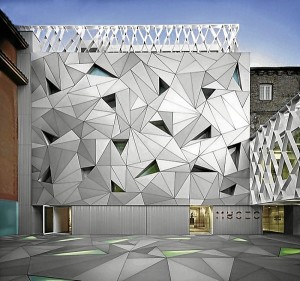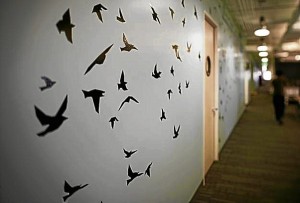Putting play to work

PLAY is essential to design. Facets interact with fluidity on the walls and pavements of this museum design by the Spanish partnership Aranguren & Gallegos.
“The creation of something new is not accomplished by the intellect but by the play instinct.”—Carl Jung, Swiss psychoanalyst
With the mind and heart at play, adults can return to child-like innocence and comfort, connecting to sources of happiness within; happiness that sparks the imagination, enhances problem-solving skills, and makes us boundlessly inventive. While need is the mother of invention, it is the playful creative process that brings ideas into the tangible world to be experienced. There is no moment more stimulating—and at the same time more calming—than a moment at play.
As adults, we do not look to play as a necessity. It is often perceived as a luxury for those who have the time and money for it. But many creative artists, entrepreneurs, artists and inventors have relied on this child-like “skill” of just enjoying and of “being,” as a prime and essential activity of their adult life and its successes. “Play,” unlike “work,” has many benefits.
The joyfulness of childhood becomes a doorway to learning and to continuous discovery. After all, when our defenses are down and we are in a blissful experience, we become more enthusiastic. When we are enthusiastic, our minds flow with ideas and imaginings.
In design, being at a moment of play can be likened to being in the “zone” or in a “high.” Within it, barriers are suddenly unhinged and ideas begin to flow. The moment comes upon the act of committing fully—heart and mind—to the activity at hand. When the restraints are set loose, enjoyment can begin.
The experience can be likened to a child sitting atop a tall slide for the first time, anticipating the thrill—and the fear—of the experience, but letting go anyway, and enjoying fully the swoop down; or a diver having the first rear roll into the sea, fearing all the things that go wrong under water, yet trusting instincts and taking the plunge anyway, later relishing the beautiful discoveries underwater.
Children have less of these fears, for they do not truly understand the risks of their movements. They experience a lack of physical and mental limitations. Play sets them free. It allows them to learn. In this manner, it can set adults free.
It is through the connection of playing while learning that innovation happens. How?
It gives us the space to focus. Play allows our curiosities to capture us, and in so doing, keep our senses attuned to the task at hand. In play, our attention is transfixed and we are entranced in our activity. Our involvement is total, and it prompts us to deeply explore our thoughts and ideas.
Playful creative process

BIRDS on the wall employ the ‘play-while-you-work-ethic’ in the Twitter offices, understanding that play unleashes the creative juices and sets the pace for innovative thinking.
It gives a sense of peace. A moment in the playful creative process eliminates all worries and concerns from the consciousness. Creative endeavors are said to be “therapeutic” or “calming” because they eliminate other concerns and keep our attention. Our thoughts are set in a positive frame of mind when we are caught in the process.
It takes us away from reality. One of the most common games is that of “pretend.” Pretend games permit us to jump beyond the boundary of the present and imagine how something might be used, or how it can be made to look. In a way, the creative process of designing is much like playing a pretend game in the mind and on paper, just before making it all part of reality.
It allows for a new means to an end. Being caught in a fight or flight situation, like that of the immense pressure to produce, can make us rely on tried and tested means of reaching our goals. But when we are not trying to “save our lives” or trying to “perform,” we can meander and explore other ways of achieving our goals. Being in a moment of play eliminates any pressure or threat, and allows us to try the untested ways of doing things.
It makes us abandon material interest. The recreation in play becomes the end in itself. If the process is an unstressed and happy one, there is no need for any “reward.” Thus, when we enjoy what we are doing and forget about the money, we can focus on the process rather than the end. The results are likelier to be successful.
Adults play with motives associated with adult responsibilities, while children play with the purity of enjoyment, that is why it is said that children “play” while adults can only be “playful.” Replenishing enthusiasm through play is invigorating, but integrating it into the creative work process is vital for innovation. Every day should be playtime, even for the adults.
Contact the author through designdimensions@abi.ph or through our Asuncion Berenguer Facebook account.
